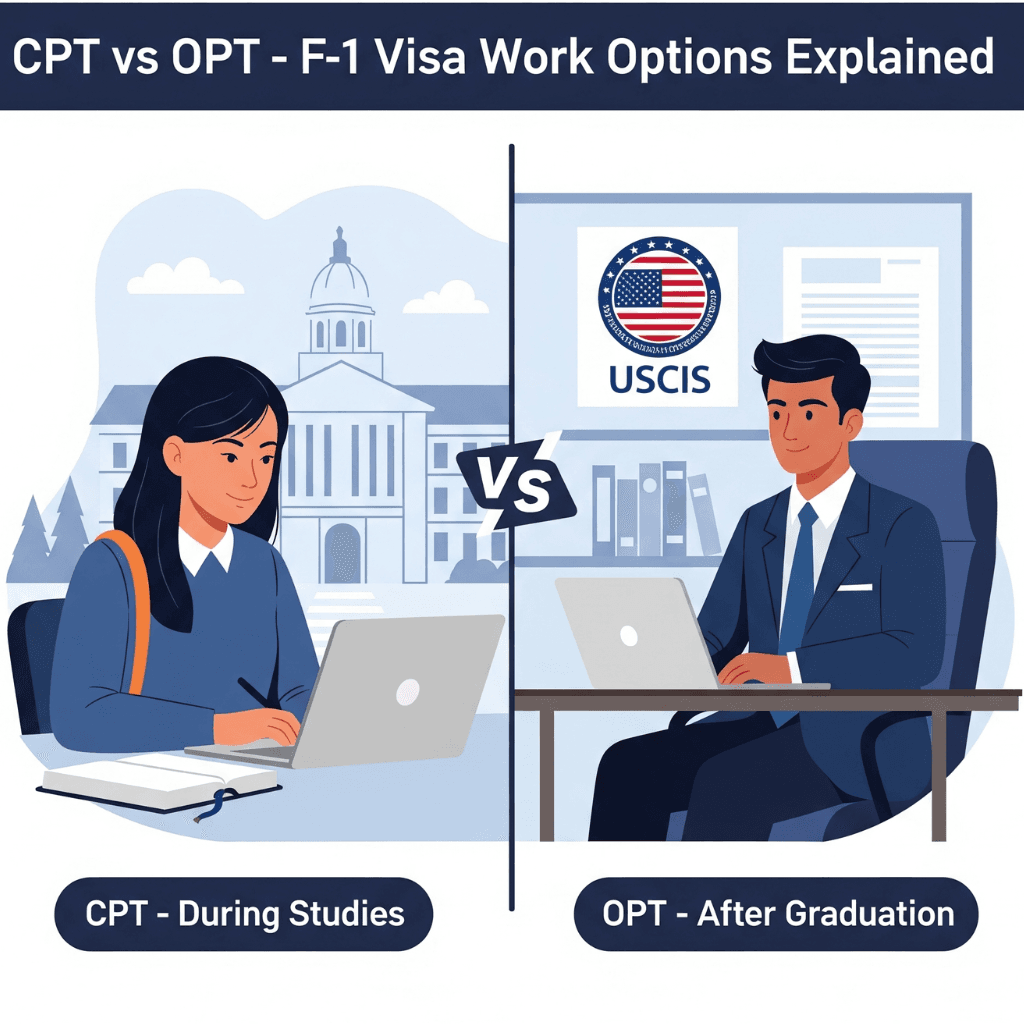CPT vs OPT – What F-1 Students Need to Know
Studying in the U.S. opens the door to valuable professional experiences that can shape your global career. If you’re an international student on an F-1 visa, you have two main options to gain legal work experience in the U.S. : Curricular Practical Training (CPT) and Optional Practical Training (OPT).
While both allow off-campus work, they differ in purpose, timing, application process, and eligibility. This guide explains the CPT vs OPT difference, helping you decide which path aligns best with your academic and career goals.
What is CPT (Curricular Practical Training)?
Curricular Practical Training (CPT) allows F-1 students to engage in internships, cooperative education, or practical work experiences that are directly related to their field of study and are part of the curriculum.
CPT: Key Features
- Purpose: Designed to provide hands-on work experience directly tied to your major.
- Timing: Only available before graduation, during your academic program.
- Academic Requirement: Must be a required or credit-bearing part of your coursework.
- Job Offer: A job offer is required before applying.
- Authorization: Approved by your Designated School Official (DSO) — no USCIS approval needed.
- Work Hours:
- Part-time CPT (≤20 hours/week): Allowed during academic semesters.
- Full-time CPT (>20 hours/week): Allowed during school breaks or if your program permits.
- Part-time CPT (≤20 hours/week): Allowed during academic semesters.
CPT Limitations
- 12 months of full-time CPT disqualifies you from OPT.
- Cannot be used after graduation.
CPT Eligibility Requirements
- Completed one academic year at a SEVP-certified school (unless your program requires earlier participation).
- Employment must be directly related to your declared major.
- Must enroll in a related course and have a job offer in hand.
Also Read: SOP vs Motivation Letter: What’s the Difference and When to Use Each?

What is OPT (Optional Practical Training)?
Optional Practical Training (OPT) allows F-1 students to gain real-world work experience in their major field of study either during or after completing their degree.
OPT: Key Features
- Purpose: To gain practical experience in your field, regardless of course credit.
- Timing:
- Pre-Completion OPT: Part-time work while still in school.
- Post-Completion OPT: Full-time work after graduation.
- Pre-Completion OPT: Part-time work while still in school.
- Job Offer: Not required when applying.
- Authorization: Requires applying to USCIS with Form I-765 to obtain an Employment Authorization Document (EAD).
- Duration:
- Standard: Up to 12 months total.
- STEM OPT Extension: Additional 24 months for eligible STEM graduates.
- Standard: Up to 12 months total.
- Application Fee: $410 (paid to USCIS).
- Taxes: OPT income is taxable; students must complete IRS forms like W-4.
OPT Eligibility Requirements
- Must have completed at least one academic year of full-time enrollment.
- Work must be directly related to your field of study.
- Requires DSO recommendation on Form I-20 and USCIS approval.
CPT vs OPT: At a Glance
| Feature | CPT | OPT |
| Purpose | Curriculum-based work experience | Practical experience post-study |
| Timing | During the program | During or after program completion |
| Job Offering | Required before applying | Not required to apply |
| Authorizaton | Approved by DSO | Approved by USCIS (Form I-765) |
| Duration | Varies by program | 12 months (up to 36 with STEM extension) |
| Affects OPT? | Yes, if full-time CPT >12 months | No |
Real-World Scenarios: Which One Is Right for You?
Choose CPT if:
- You’ve received an internship offer tied to your coursework.
- Your thesis or capstone requires practical work experience.
- You want to gain relevant experience before graduating.
Choose OPT if:
- You want to work in the U.S. after graduation.
- You’re seeking flexibility without course-related restrictions.
- You’re a STEM student planning to extend your U.S. stay.
- You’re planning an H-1B visa transition (OPT provides cap-gap coverage).
Bonus: On-Campus Employment for F-1 Students
Aside from CPT and OPT, F-1 students can also work on-campus without special authorization.
On-Campus Work Guidelines:
- Up to 20 hours/week during academic semesters.
- Full-time during holidays and academic breaks.
- Eligible jobs include positions in libraries, dining halls, bookstores, etc.
- No need for CPT or OPT approval.
Navigating U.S. Work Opportunities as an F-1 Student
Choosing between CPT and OPT depends on your degree requirements, career goals, and job prospects. Both are valuable ways to gain U.S. work experience and enhance your resume.
Always consult your Designated School Official (DSO) early in your program to map out your timeline and ensure you stay compliant with immigration regulations.
What is the difference between CPT and OPT for F-1 students?
CPT (Curricular Practical Training) is work experience tied to your academic curriculum and requires a job offer, while OPT (Optional Practical Training) is more flexible and allows work in your field of study during or after graduation, with or without a job offer. CPT is approved by your school; OPT requires USCIS authorization.
FAQs.
1. Can I do both CPT and OPT?
Yes, but using 12+ months of full-time CPT makes you ineligible for OPT. Part-time CPT does not affect OPT eligibility
2. Can I switch from CPT to OPT?
Yes. Many students use CPT during their studies and apply for OPT after graduation.
3. How long does OPT approval take?
Typically 2–4 months. It’s recommended to apply up to 90 days before your program ends.
4. Do I pay taxes on CPT or OPT income?
Yes. Both are taxable. You’ll need to file federal and possibly state taxes.
5. Can I work full-time on CPT during the semester?
Only if your academic program specifically allows it, otherwise CPT is limited to part-time during semesters.
1 thought on “CPT vs OPT: Key Differences for F-1 Visa International Students (2025 Guide)”